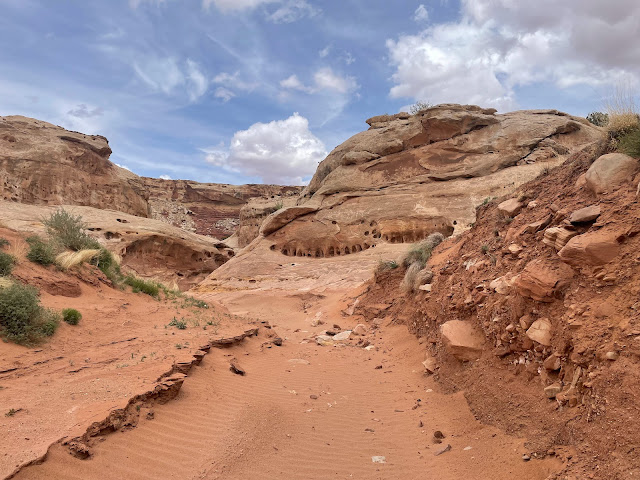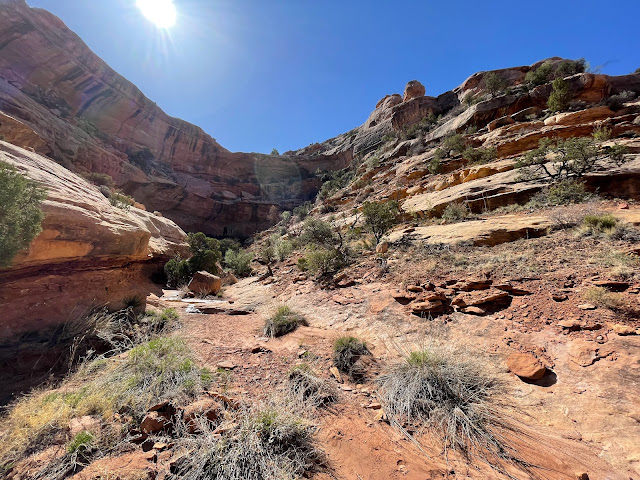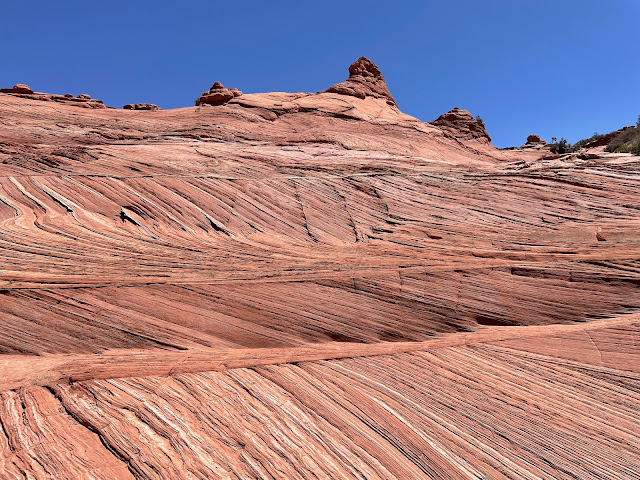In 2019 during my WASU itinerary I had passed through the Eastern section of the Maze in Canyonlands NP from Spanish Bottom through Ernie’s country to the Golden Staircase bypassing most of the Maze. I had always thought of returning to the right bank of the Colorado river and hike through the Maze. This year this came to pass.
The geography of the Maze is like that of an inverted wedding cake with three layers. This analogy is imperfect as in a layer cake the upper layers are smaller in circumference whereas in the Maze the reverse is the case: as you go down the circumference of the lower layers decreases as you go down. At the top layer you are at the level of I-85 and UT 24 that connects Hanksville to the interstate. You drive for some 48 miles on a dirt road from highway 24 to the Hans Flat ranger station. There they will relieve you of a chunk of change (they are just being helpful, you would not want to have to carry all that cash through the backcountry, would you now?). You can then take a 4x4 vehicle along the Flint trail down to the next layer. It is important to note that the 4x4 character of your vehicle is important, but much more important is that you actually know how to make use of the characteristics of the vehicle. Taking the kids to soccer practice in a 4x4 is not sufficient experience to drive this road, whatever your vehicle. If you have to ask how much it might cost if you were to get stuck and had to be towed, you can’t afford it.
Anyway, on this mid layer, about 700 ft below the top layer, there are several drive-in camp spots at a variety of geological odd spots. From the mid-layer you can climb down about another 500-700 ft to the bottom layer, which is only accessible to backpackers and hikers, and not to vehicles.
I drove the first 2.5 miles of the Flint trail, the easiest section of this road for sure, to a parking spot near North Point, and then descended the North Point trail to the mid-layer. It’s an easy first mile and a half and then you stand at the top of the abyss and have to make your way down a dirt/scree/talus slope into a drainage which you then follow out. I camped on a slightly elevated bank of the drainage bed. The weather looked stable and a flash flood seemed to be unlikely to happen overnight. You’d positively not want to be there in a flash flood!
The descent drainage near North PointLooking back mid-descent at a dryfall
Next day day I continued along the drainage as it entered into the wide bowl that is the mid-layer level. For a while I followed a trail, but at some point lost that. Not a problem as I knew that at some point I was going to hit the road that connects the Flint trail to the road leading to an overview point of Horse canyon. The road appeared as expected and I could connect easily to the road that leads to the Maze Overlook and the camp sites located there. I made a good decision here, more by intuition than on the basis of hard knowledge, by deciding to enter the bottom layer of the Maze via Horse canyon rather than the Brimhall trail by Maze Overlook. The latter is a piece of work as I found out while climbing it. Downclimbing it with six days of food and a day and a half worth of water would not have been my idea of fun.
Elaterite Butte
Along the road in the mid-layer
The trail into Horse canyon is a rough dirt/talus slope without issue. You enter the Horse canyon drainage downstream of a major dryfall and then walk the next seven miles or so in a dry stream bed over sand and fine gravel with a minor slickrock narrows/slot canyon thrown in for good measure. I camped near the junction with a trail that leads to an overlook of the Colorado. The entire day had been completely dry, plenty of traces of past water flow but no drop of water anywhere.
Atop Horse Canyon near the entry
In the drainage of Horse canyon
Next morning I made my way to Brimhall Point and encountered lots of water in its vicinity, both flowing and as stagnant pools of clear cold water. I continued along the South Fork of Horse canyon, winding my way hither and fro following the drainage. Plenty of water, not continuously but intermittently. I camped near the spring shown on the USGS map, keeping the required 300 ft distance to the spring. It was a cold and windy night, the narrow drainage channeling the wind.
Next morning I continued to the end of the South Fork and climbed up to the mid-layer. This is an intricate affair and not at all intuitively obvious. After some climbing you end up in a seemingly dead-end drainage with 30+ ft walls. But fear not, the cairns lead you to the other side of one of the walls and there the big wall is broken up into three less intimidating terrasses that you can take one by one. Once you are on top you return to the dead-end drainage, but now on top of the intimidating wall and continue climbing up to the road leading to “The Plug”, “The Wall”, and “Lizard Rock”, three of the geological oddities highlighted on the maps of this area. I walked the road for a while, encountering only one convoy of two Jeeps from a commercial outfit in Moab that was returning from a kayaking trip at Spanish Bottom.
Apparent dead end. You contour around the ridge on the right
Rock pile assist: the bottom two thirds are built to "federal standards", the top third was added by hikers (it was wobbly)
An arch in Ernie’s country as seen from the road near “The Wall”
Near “The Plug” I located the very discrete cairns indicating the trail that was to lead me back to the bottom layer of the Maze. This downclimb was another intricate affair. After crossing some dirt and slick rock plain you start descending into a bowl on slick rock and at some point find yourself on a ledge about 100 ft above the bottom of a bowl with essentially vertical walls. You start to wonder how that’s supposed to work. But, again, fear not as eventually you reach a pass leading into another bowl and its walls are steep but climbable. At the bottom you walk another sandy/gravelly drainage bottom. At a dryfall I found a decent size pool with decent water and camped shortly thereafter, about a mile from the junction with a canyon that would lead me to “Standing Rock” the next morning. It was beautiful afternoon and evening, no wind for once and the temperature very pleasant all night.
Dryfall with pool
Next morning I made it to the junction with the canyon that would lead me to “Standing Rock”. The climb at first was a bit of a messy affair up a dirt slope until I hit slickrock. There I met Mike, a Hayduke hiker, and we started chatting after I had stated that I had completed the Hayduke the year before. He told me about his plan to get to Happy Canyon and I could comment based on my WASU hike from 2019 when I also had reached Happy Canyon via Canyonlands NP. Mike had a very unique itinerary in that he had floated down the Green River from Green River in a packraft and had gotten out at Spanish Bottom. He had gotten out of the Colorado at the exact same spot I had exited five years earlier, but he did at low tide while I had to do so at high tide. It was fun to meet someone who also had taken this somewhat unusual a route. Mike is a physical beast, having completed the AZT before starting the Hayduke. Not only that, but he had had to snowshoed some 220 miles of the last 300 of the AZT! I can’t even!
Trying to get back down. How's that supposed to work?
The contour leads you to this pass and that looks very doable. And it is
After completing the climb out, I followed the cairned route across Pete’s Mesa with beautiful views of the deeply snow covered LaSal mountains near Moab. The downclimb to the bottom layer was again an intricate affair and a longish and tiring walk through yet another sandy/gravelly drainage bottom brought me to the bottom of the Brimhall trail below the Maze Overlook. I camped there with the intention of getting an early start next morning as I needed to get all the way back to near North Point, either all the way to my car or within a mile of the road, the last legal spot to camp.
The moqui steps, about 12 ft height
The "Butt crack" (in the shade). You have to shimmy your way up that crack
The hardest part is done, but for some contouring and some minor scrambling
On top!
Look back to where I started 0.8 miles and 90 min earlier
The Brimhall trail. What a piece of work! It starts out easy enough across dirt slopes. Then comes the first steepish slickrock friction climb which leads you to a steep wall with Moqui steps hewn into the rock. Best done without a pack, so you need a rope to be able to pull the pack up after you. Shortly thereafter you reach a butt crack that you have to shimmy yourself up, again without pack. After having pulled it up after you, you reach another short flight of Moqui steps. After having overcome that, the most difficult part is behind you. There is still one ledge one has to ease one’s way across to a weakness in a rockface. The only way I could manage to get up that thing was to shimmy my butt up and then crab walk backwards until I could get past my pack and stand up. After that there was some ledge walking without exposure and a few minor cliff bands not worth talking about. The map says the trail is 0.8 miles long. It took me 75 minutes, including breaks to catch my breath.
At the top I ran into some humanity in the form of a commercial group of hikers/bikers out for a day hike. After a brief chat I continued along the road around Elaterite Butte, passed the spot where I had left the road a few days earlier to descend into Horse canyon. A short while later I came to the road junction and soon thereafter I found the single track leading to North Point at its intersection with the road, followed it for a while and lost it again some time later. Walking cross-country I latched onto the faint traces of an old road and that got me back into the drainage I had followed after my first camp. Given the opportunity I apparently overlooked a cairn somewhere that would have enabled me to sidestep a rockfall and a dryfall. So I did some extracurricular work getting through a rockfall with some truly giant rocks and big holes between those rocks. A real work-out! Above the rockfall the drainage narrowed considerably and it looked as if I was going to find myself under a dryfall. However, I continued and the “dryfall” really was just an overhanging ledge and the drainage went through to a modest dryfall that was relatively easy to climb. Above the dryfall I joined again the cairned route through the narrow drainage, no opportunity to miss any cairn and to go on an adventure of my own. At the end I decided to climb out of the drainage as I recalled that there had been a pothole with water about two thirds up the climb. I got two liters there, completed the climb to within about 1.5 miles of my car and spent my final night there.
Overall I had a great time and I enjoyed the scenery in the Maze very much. All of the climbs and descents had been fun and the walking in the sandy drainages had not been too much of a bear. The dramatic scenery certainly helps to distract you. If I were to go back, I would take some time to explore the side canyons of the major canyons in the Maze. However, on foot, it is logistically difficult as you need to have two or three days’ worth of food to get to the bottom and back out, then you have to get into, say, South Fork of Horse canyon and have to have enough food to be able to explore. Something to puzzle out!






















































